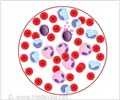A critical first step for the development of safer and more effective stem cell therapies for patients with leukemia, multiple myeloma and anaemia has been taken by scientists at UC San Diego.
They've identified the specific region in vertebrates where adult blood stem cells arise during embryonic development.The researchers say their time-lapse imaging of the process, by which primitive embryonic tissues first produce the parent stem cells that produce all adult blood cells over the life of an individual, should help guide future efforts to repair and replace this cell population for therapeutic purposes.
Current transplantation therapies rely on the infusion of donor stem cells into a patient's bone marrow to generate new, healthy blood cells without disease.
But that procedure is often risky and can result in fatal complications, due in part to "graft-versus-host disease," in which transplanted cells react against foreign tissues of the recipient.
One means of circumventing this immune rejection problem would be to generate hematopoietic stem cells, or HSCs, using the patient's own precursor cells.
Such cells would be perfectly genetically matched, but in order to generate such cells, scientists must first understand the molecular processes that underlie specification of HSCs.
Advertisement
"Our findings are an important step toward this goal because they provide a better understanding of how HSCs, the cell type responsible for the clinical benefits of bone marrow transplants, are first specified during development.
Advertisement
Traver and his colleagues made their discoveries in zebrafish, a model laboratory organism for geneticists in which embryos are transparent, allowing the researchers to observe and track individual stem cells with a microscope.
"Using zebrafish embryos with fluorescently labeled tissues, we were able to demonstrate that HSCs arise directly from cells lining the floor of the dorsal aorta by imaging the process in living embryos."
The study appears in this week's early online edition of the journal Nature.
Source-ANI
RAS












